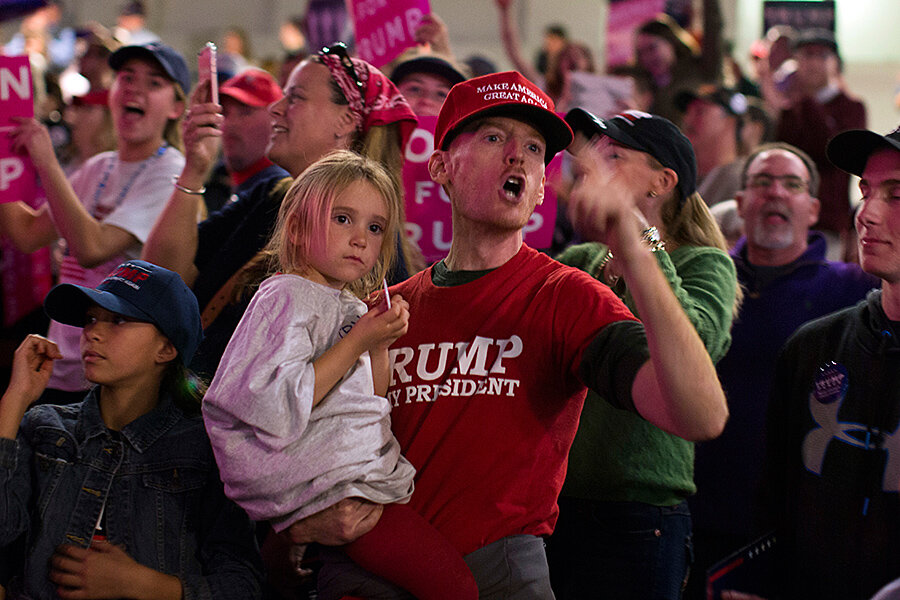When hostility to media becomes assault
Loading...
| New York
Lots of politicians aren’t happy to see reporters. From the point of view of elected officials, the press comes at them from all angles, always wanting answers. It’s tough to free yourself. It’s like they’re a swarm of ants.
Lots of politicians have demeaned reporters for partisan purposes over the years. It’s been almost five decades since Vice President Spiro Agnew roused GOP voters by calling the media “nattering nabobs of negativism” (words penned, perhaps ironically, by future New York Times columnist William Safire).
But as US politics becomes increasingly polarized and partisan a heightened tone of hostility may be seeping into the relationship between reporters and the politicians they cover.
On Wednesday Greg Gianforte, a Republican candidate for Congress in Montana, physically assaulted a reporter asking a question about health care.
Last week, Federal Communications Commission security pinned a reporter against a wall after he tried to question FCC commissioners. And earlier this month, West Virginia police arrested a veteran reporter for trying to question Secretary of Health and Human Services Tom Price in the state capitol.
President Trump’s depiction of the mainstream media as lying, grasping, and a failure – and a large number of Americans who agree – may have shaped the environment in which these events occurred.
The bottom line: This rolling ball of conflict doesn’t help either side. The press, in particular, is vulnerable to further erosion of its position. Technology long ago cracked open the old mainstream media’s ability to define what is and isn’t news. Now Mr. Trump’s tweets and the insidious rise of fake news are going after what’s left of mainstream media credibility.
“I don’t look for the situation to improve anytime soon,” says Jeff McCall, professor of media studies at DePauw University in Greencastle, Ind., via email. “The press needs to step up its professional behavior and societal leaders must be more open to public scrutiny. There’s little evidence now that either of those things are ready to happen.”
It’s the Gianforte incident in Montana that suddenly inserted this subject into Americans' social media news feeds. Gianforte, the GOP candidate for an open House seat in Montana and former wrestler, grabbed a reporter for the British newspaper The Guardian around the throat and body-slammed him to the ground. His anger was apparently sparked by a question about the new Congressional Budget Office analysis of the cost and coverage of the Republican health-care bill. According to an audiotape and three eyewitnesses from Fox News, the candidate reacted violently only a few seconds into the conversation.
Mr. Gianforte’s office initially blamed the reporter, Ben Jacobs, citing “aggressive behavior from this liberal journalist.” The campaign's version of events is not borne out by the tape of the encounter.
Gianforte has not apologized for the alleged attack, which has upended an election that ends with voting today. Local authorities charged him with misdemeanor assault.
Tension between candidates and reporters is natural, note media experts. Campaigns are tiring and emotional. Journalists push tough issues, such as the GOP effort to repeal Obamacare, which candidates and their staffs may view as things they would particularly like to avoid.
That said, it’s not natural for a candidate to snap and turn an encounter into a wrestling match. It may have been only a flawed personal decision. But it also may have been a flawed personal decision made in a larger cultural context, says Paul Levinson, professor of communications and media at Fordham University in New York.
“There’s no doubt that the contempt and hostility expressed by Donald Trump toward the press, both in the campaign and continuing in his presidency, has created a climate in which unstable politicians who can’t control their violent impulses, like Greg Gianforte in Montana, act out their violence and physically attack reporters,” says Professor Levinson.
A question, then an arrest
The physical restraint of an inquiring reporter at the FCC and the arrest of a journalist questioning HHS Secretary Price in West Virginia weren’t as violent, but in some ways were just as troubling, say other media analysts. The reporter in the FCC incident, John Donnelly of CQ Roll Call, is a respected Washington veteran. He was shadowed by guards as he walked the FCC halls, as he is allowed to do. When he approached a commissioner for an inquiry, guards backed into him and pinned him against the wall.
The reporter in West Virginia, Dan Heyman, who works for Public News Service, was standing in a hallway when Price approached. (Price was in town to study the opioid crisis.) Mr. Heyman said he “yelled out” a question on the treatment of pre-existing conditions in the GOP health bill. Price didn’t answer, so he tried again. The Secret Service then handcuffed and arrested him and charged him with “willful disruption of government processes.”
The facts of these cases matter. Further description could put them in a different light. Still, they may be symptoms of today’s media age, says Aram Sinnreich, professor of communications at American University in Washington.
“There’s a common thread uniting many of these incidents,” says Professor Sinnreich. “Trump’s consistently incendiary language against the press, the administration’s overt antipathy and exclusion of the press, and the tacit or explicit celebration of this rhetoric.”
When truth gets politicized
The point of these attacks, according to Sinnreich, may be to undermine the credibility of journalism as an enterprise. It’s similar to the way some conservative attacks on climate change theory charge that scientists are politically motivated. It’s an effort to erode the authority of experts.
“To many people, the journalistic method, like the scientific method, just becomes another arbitrary and politicized type of truth claim, with no logical or moral high ground,” says Sinnreich.
Other experts don’t see these incidents as being so indicative. Especially in the Gianforte case, a punch might be just a punch. There have been previous descriptions of Gianforte as being inexperienced and thin-skinned for someone running for such a visible political position.
“Maybe this is more about him in this case rather than anything else,” says Patrick Miller, a professor of political science at the University of Kansas in Lawrence, who studies partisanship and polling methods.
Angry politicians have been known to physically assault each other, Professor Miller points out. One person can explode. The point now is for the GOP as a whole to condemn the action, he says. Otherwise the larger organization appears to condone it.
“Parties have to enforce norms,” Miller says.
Press credibility declining before Trump
And while it’s true that Trump has skillfully exploited the public’s fears and concerns about the press during his campaign, it’s not as if he was attacking institutions held in august regard by the public. The standing of the press has been declining for years, notes Professor McCall of DePauw University.
“The press’s credibility has declined by fifteen percentage points in fifteen years, so public perception of media decline was well underway before the Trump campaign,” McCall says
The public just no longer believes the media has citizens’ interests in mind, according to McCall. It sees news outlets as too sensational and eager to profit and driven by their own particular agendas.
“Overall, there is little sense today in America about what a free press was created to do,” McCall says.








